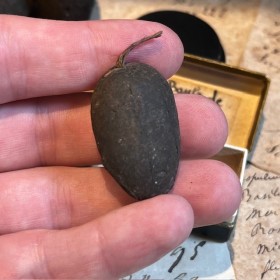- New












Boule de Nancy - Genuine Mars Vulnerary Ball - Steel Ball
This iron-containing ball was once considered a miracle cure for many ailments and injuries.
The Boule de Nancy is sold individually in a small antique drugstore box
Unavailable today
Boule de Nancy - Genuine Mars Vulnerary Ball - Steel Ball
Boule de Nancy were a medicine generally prepared with potassium tartrate and iron tartrate.
They are often referred to as boules de Nancy (Nancy balls), as they were mainly made in this city, due to the quality of iron from Lorraine, and an important local tradition.
This steel ball was once considered a medicine.
Its name derives from its iron content and its generally black ball shape. The ball was fitted with a small loop (ribbon or cord) to enable it to be hung vertically. The ball was marked with the cross of Lorraine, a bar of which is vaguely visible today on the ball.
There were various ways of ingesting it, but the most common was to partially dissolve it in water or brandy. The result was boule water.
The uses to which the water extracted from these steel balls was put were varied, and the notices of the time evoke a Prévert-like inventory:
There were various ways of ingesting it, but the most common was to partially dissolve it in water or brandy. The result was ball water.
The water extracted from these steel balls was used in a variety of ways, and the notices from the time give a brief overview of the many uses:
Wounds, cuts, bruises, haemorrhages, migraines, colic, fluxions, dislocations, pleurisy, sciatica, rheumatism, spleen hardness, mother's sickness or vapours, loss of blood, pale colours, extraction of thorns (from any part of the body), weakening of the stomach, tongue-tied secretions, obstructions of the liver, spleen, of the glands of the mesentery, hypochondriac, ‘histeric’, vaporous affections, suppression or slowness of the menstrual flow, chronic diseases of the lungs, phthisis (without haemorrhage or continuous slow fevers), suppuration of the kidneys, gravel, gout, long-term fever, inflammations of the gullet, tongue, ophthalmia, recent wounds, contusions, strains, sprains, fractures.
This remedy was mentioned in the Strasbourg Pharmacopoeia in 1725 and shortly afterwards in the Paris Pharmacopoeia in 1732.
Boule de Mars was included in the French Pharmacopoeia in the 20th century until 1972, when it fell into disuse in the face of new iron-containing medicines that were more effective than tartrate.
But what does Boule de Nancy contain?
According to Nancy recipes, ball is made with steel filings, tartar and brandy.
But the tartar and filings had to be immersed twice beforehand in water and the third time in aromatic alcohol obtained by distilling an alcoholic infusion of vulnerable species (plants used to heal wounds and injuries), which could contain up to twenty different plants. Fennel, calament, lemon balm, sage, thyme, wormwood, rosemary, benzoin, myrrh, etc. were used to make the ball.
The resulting dough was then shaped into balls weighing 30 grams, roughly the size of a pigeon's egg. A ribbon or cord was included in the body of the ball, so that it could be hung up to dry in the air and used again later.
Dimensions: The Boule de Nancy looks more like an almond, about 4 cm long.
The Boule de Nancy is sold individually in a small antique drugstore box
Unavailable today